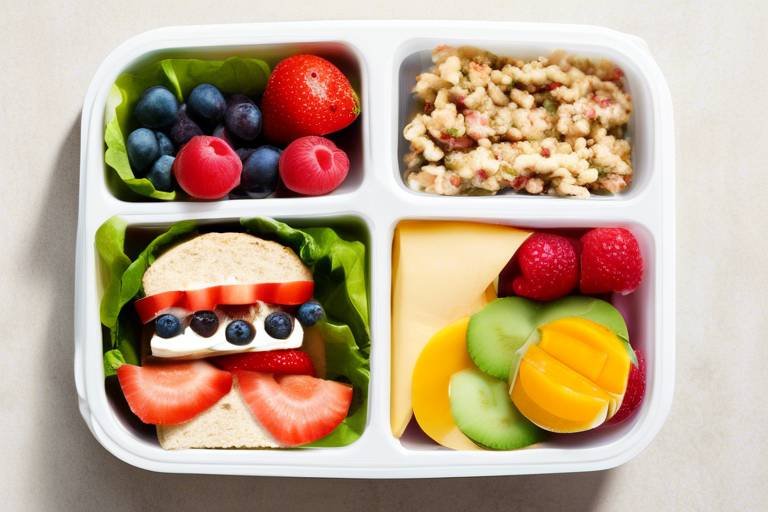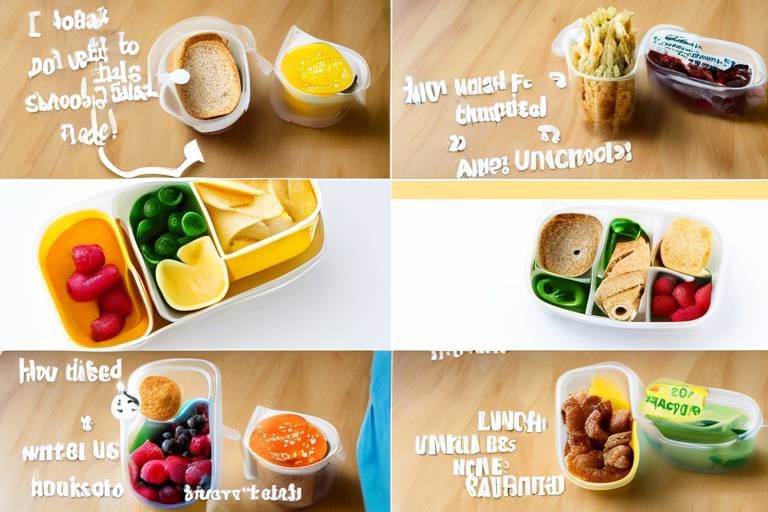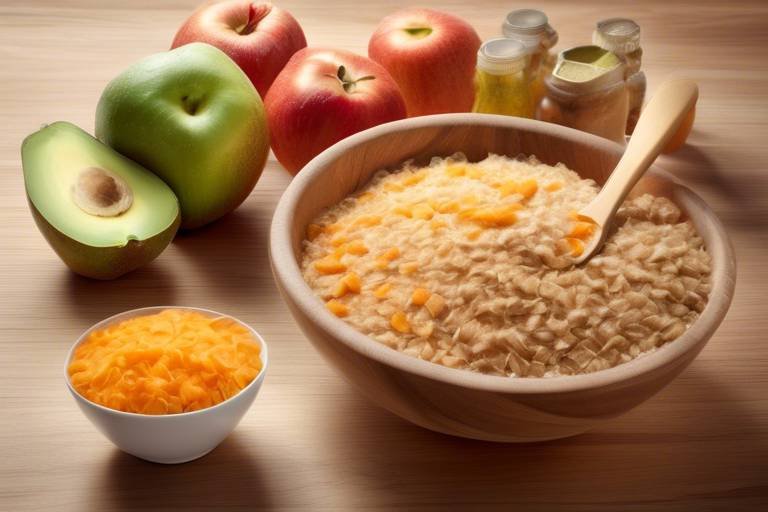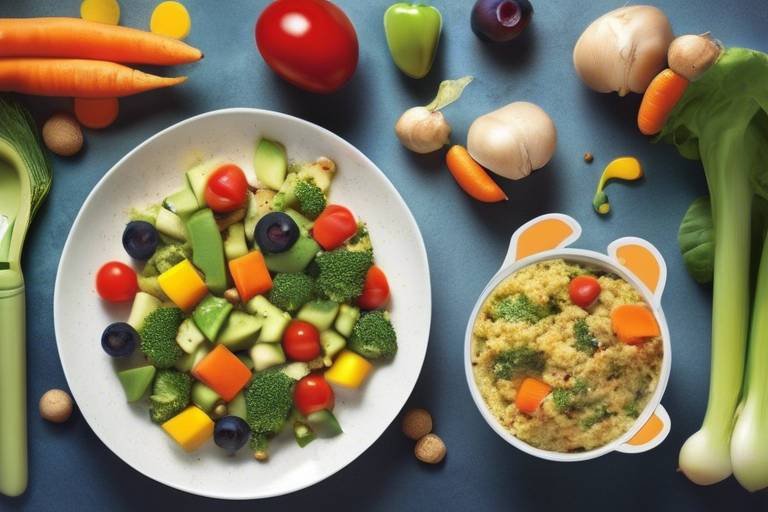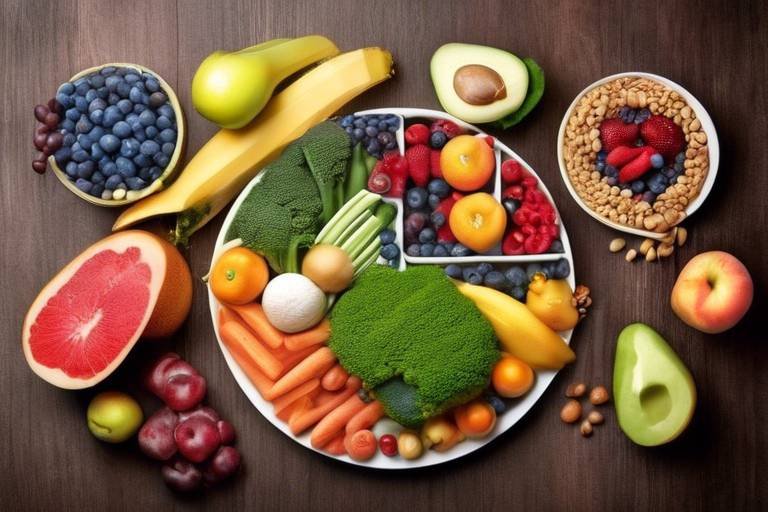Meal Planning 101: A Guide for Beginners
Welcome to the world of meal planning, where the chaos of last-minute cooking transforms into a well-orchestrated symphony of delicious, healthy meals. Imagine waking up each day, knowing exactly what you're going to eat without the stress of scrambling through your pantry or running to the grocery store at the last minute. Sounds dreamy, right? This article provides an essential introduction to meal planning, offering beginners practical tips, strategies, and insights to simplify the process and make healthier eating choices.
So, what exactly is meal planning? At its core, meal planning involves organizing meals in advance. It’s like mapping out a road trip; without a plan, you might end up lost or making unnecessary stops. By planning your meals, you save time, reduce food waste, and promote healthier eating habits. It empowers you to make informed choices while enjoying a variety of foods throughout the week. Think of meal planning as your personal guide to culinary adventures, where each meal is a new destination waiting to be explored!
Why should you care about meal planning? Well, let’s dive into the numerous advantages it offers:
- Save Money: By planning ahead, you can buy in bulk and avoid those impulse purchases that can drain your wallet.
- Save Time: With a solid plan, you’ll spend less time in the kitchen during the week.
- Improve Nutrition: Meal planning allows you to make healthier choices, ensuring you get a good balance of nutrients.
- Reduce Stress: Forget the nightly “What’s for dinner?” dilemma. A meal plan takes the guesswork out of your meals.
These benefits can motivate anyone, especially beginners, to adopt this valuable practice in their daily lives. Just think about how much easier your week could be!
Effective meal planning can significantly cut down on cooking time during the week. Who wouldn’t want to spend less time cooking and more time enjoying life? Here are some strategies to streamline your meal prep:
- Batch Cooking: Prepare large quantities of food at once, allowing for easy reheating and diverse meal options throughout the week.
- Utilizing Leftovers: Get creative with your leftovers! They can be transformed into new meals, minimizing waste and maximizing flavor.
Batch cooking is a game-changer for busy individuals. Imagine cooking a big pot of chili or a tray of roasted vegetables on Sunday, and you have meals ready for the week! Here are some best practices for successful batch cooking:
- Choose recipes that store well and are easy to reheat.
- Invest in good-quality containers for storing your meals.
- Label your meals with dates to keep track of freshness.
Leftovers can be a lifesaver in meal planning. Instead of tossing them in the fridge and forgetting about them, consider these creative ways to repurpose them:
- Transform last night’s roasted chicken into a hearty chicken salad.
- Use leftover vegetables in a stir-fry or omelet.
- Make a soup or stew with any remaining ingredients.
By thinking outside the box, you can minimize waste and keep your meals exciting!
Crafting a meal plan requires some thought and organization. Start by assessing your dietary needs and preferences. Do you prefer vegetarian meals, or are you a meat lover? Once you have a clear idea of what you want, it’s time to outline essential steps to create a balanced and varied meal plan:
- Decide on the number of meals you need for the week.
- Incorporate a variety of proteins, grains, and vegetables.
- Consider your schedule; plan for quick meals on busier days.
Once your meal plan is established, shopping efficiently is crucial. Here are some tips on creating a shopping list, choosing fresh ingredients, and sticking to your budget while grocery shopping:
Selecting fresh, high-quality ingredients is vital for meal planning success. Look for seasonal produce to ensure you’re getting the best flavors and prices. Here are some tips for identifying fresh ingredients:
- Check for vibrant colors and firm textures in fruits and vegetables.
- Smell your produce; fresh items will have a pleasant aroma.
- Visit local farmers' markets for the freshest options.
Meal planning doesn't have to break the bank! Here are some practical tips for shopping on a budget without sacrificing nutrition or flavor in your meals:
- Plan meals around sales and seasonal items.
- Use coupons and loyalty programs to save money.
- Buy store brands; they often offer the same quality at a lower price.
Q: How do I start meal planning?
A: Begin by assessing your dietary needs and preferences, then create a meal plan for the week. Choose recipes that excite you!
Q: How can I make meal planning easier?
A: Keep it simple! Start with a few recipes you love, and gradually expand your meal repertoire as you get comfortable.
Q: What if I don’t like leftovers?
A: Get creative! Repurpose leftovers into new dishes, or freeze them for later use.
In conclusion, meal planning is a powerful tool that can transform your eating habits and simplify your life. With a little practice, you'll find yourself enjoying delicious meals without the stress. Happy planning!

Understanding Meal Planning
Meal planning is more than just a trendy buzzword; it’s a transformative approach to eating that can significantly enhance your lifestyle. At its core, meal planning involves organizing meals in advance, which can save you time, reduce food waste, and promote healthier eating habits. Imagine walking into your kitchen each day knowing exactly what you’re going to eat, without the last-minute scramble or the temptation to order takeout. Sounds appealing, right?
When you engage in meal planning, you empower yourself to make informed choices about your diet. Instead of relying on impulse buys at the grocery store or unhealthy snacks when hunger strikes, you create a roadmap for your meals. This roadmap allows you to enjoy a variety of foods throughout the week, ensuring that you don’t fall into the monotony of eating the same thing every day. Think of it as being the captain of your ship, steering clear of the rocky shores of poor dietary choices.
One of the biggest advantages of meal planning is its ability to simplify your life. By dedicating just a little time each week to plan your meals, you can transform your eating habits and even your grocery shopping experience. For instance, you can sit down for a few minutes on a Sunday, jot down your meal ideas for the week, and create a shopping list based on those meals. This not only saves you time during the week but also helps you avoid unnecessary spending on items you don’t need. Plus, it’s a great way to ensure you’re eating a balanced diet, as you can incorporate a variety of food groups into your meals.
Meal planning also fosters creativity in the kitchen. You might find yourself experimenting with new recipes and ingredients that you wouldn't have considered otherwise. For example, if you plan a Mediterranean-themed week, you might try your hand at making homemade hummus or a vibrant tabbouleh salad. This exploration can make cooking fun and enjoyable, rather than a chore. It’s like being an artist, where your kitchen is your canvas, and the ingredients are your paint!
In summary, understanding meal planning is about recognizing its potential to streamline your meals, enhance your nutritional intake, and reduce stress. By taking the time to plan, you’re not just organizing your meals; you’re also investing in your health and well-being. So, why not give it a shot? You might find that meal planning becomes a delightful part of your weekly routine!

Benefits of Meal Planning
Meal planning is not just a trendy buzzword; it’s a game changer for anyone looking to enhance their eating habits and simplify their life. Imagine walking into your kitchen each day with a clear plan, knowing exactly what you’re going to eat without the last-minute scramble. That’s the magic of meal planning! It empowers you to make healthier choices, reduces food waste, and can even save you money. Let's dive deeper into the myriad of benefits that meal planning brings to the table.
First and foremost, one of the most significant advantages of meal planning is the potential for cost savings. By planning your meals ahead of time, you can create a precise shopping list that helps you avoid impulse buys at the grocery store. This not only keeps your budget in check but also minimizes the chances of food spoilage. For instance, if you plan to use certain ingredients across multiple meals, you can ensure that everything you buy gets used up. Think of it as a smart investment in your health and finances!
Furthermore, meal planning can drastically reduce the time you spend in the kitchen. Who doesn’t want more free time? When you dedicate a few hours on the weekend to prepare meals for the week, you can cut down on daily cooking time. You can batch cook grains, chop veggies, and even cook proteins in advance. This way, when it’s time to eat, you simply heat everything up or toss it together. It’s like having a personal chef at your fingertips!
Another compelling benefit of meal planning is improved nutrition. With a well-thought-out plan, you can ensure that your meals are balanced and include a variety of nutrients. You can make conscious decisions about including fruits, vegetables, whole grains, and lean proteins in your diet. This proactive approach to your meals can lead to healthier eating habits. Plus, when you have meals prepped, you’re less likely to reach for unhealthy snacks or fast food options when hunger strikes.
Stress reduction is yet another fantastic benefit of meal planning. How many times have you found yourself staring blankly into the fridge at 6 PM, wondering what to make for dinner? With a meal plan in place, you eliminate that daily dilemma. You can approach each week with a sense of calm, knowing that you have nutritious meals ready to go. It’s like having a roadmap for your week, guiding you through the chaos of daily life.
Let’s not forget about the environmental impact of meal planning. By reducing food waste, you’re contributing to a more sustainable lifestyle. When you buy only what you need and use all the ingredients you purchase, you’re minimizing the amount of food that ends up in landfills. It’s a small step that can lead to significant changes in our planet’s health.
In summary, the benefits of meal planning are both extensive and impactful. From saving money and time to improving nutrition and reducing stress, it’s a practice that can transform your relationship with food. So, why not give it a try? You might just find that meal planning is the secret ingredient you’ve been missing!
- What is meal planning? Meal planning is the process of organizing meals in advance to help streamline cooking, save time, and promote healthier eating habits.
- How can meal planning save me money? By creating a shopping list based on your meal plan, you can avoid impulse purchases and reduce food waste, leading to significant savings.
- Is meal planning time-consuming? Initially, meal planning may take some time, but it ultimately saves you time during the week by reducing daily cooking and decision-making.
- Can meal planning help with healthy eating? Yes! Meal planning allows you to make conscious choices about ingredients and portion sizes, leading to a more balanced diet.

Time-Saving Strategies
When it comes to meal planning, time is often of the essence. We all lead busy lives, and the last thing we want is to be stuck in the kitchen for hours on end. That's where come into play. By implementing a few smart techniques, you can significantly cut down on cooking time during the week, allowing you to focus on other important aspects of your life.
One of the most effective methods is batch cooking. This technique involves preparing large quantities of food at once, which can then be portioned out and stored for later use. Imagine whipping up a big pot of chili or a hearty vegetable soup on a Sunday afternoon. Not only does this provide you with meals for the week, but it also allows for a variety of options when you mix and match different sides and toppings. When you open your fridge, you’ll have a treasure trove of ready-to-eat meals that just need a quick reheat.
Another fantastic time-saving strategy is to utilize leftovers creatively. Leftovers don’t have to be boring; they can be the foundation for exciting new meals! For instance, if you roast a chicken on Monday, why not turn the leftovers into a delicious chicken salad or a savory stir-fry on Tuesday? This not only minimizes waste but also keeps your meals fresh and interesting. You can even create a “leftover night” where you get to be a culinary artist, mixing and matching various elements from your week’s meals into something entirely new. Think of it as a fun puzzle, where the pieces are your leftover ingredients!
Additionally, consider prepping your ingredients in advance. Spend a little time on the weekend washing, chopping, and storing your fruits and vegetables. This way, when it comes time to cook during the week, all you have to do is grab and go. It’s like having your own personal sous-chef, ready to help you whip up a meal in no time!
To summarize, here are some quick time-saving strategies to incorporate into your meal planning routine:
- Batch Cooking: Prepare large portions of meals that can be easily reheated.
- Utilize Leftovers: Transform leftover meals into new dishes.
- Prepping Ingredients: Wash and chop vegetables ahead of time for easy access.
By adopting these strategies, you’ll not only save time but also enjoy the process of cooking and eating healthier meals. Remember, the goal of meal planning is to make your life easier while enjoying a variety of delicious foods. So, roll up your sleeves and get ready to enjoy the benefits of efficient meal prep!
Q: How often should I plan my meals?
A: It depends on your schedule, but many people find that planning meals weekly works best. This way, you can adjust based on your upcoming activities and ensure you have everything you need.
Q: What if I don't like cooking?
A: Meal planning can still work for you! Consider batch cooking simple recipes or using pre-prepared ingredients from the grocery store. You can also involve family or friends in the cooking process to make it more enjoyable.
Q: How can I make meal planning more exciting?
A: Experiment with new recipes, themes (like Taco Tuesday), or cuisines each week. This keeps things fresh and fun while you explore different flavors!

Batch Cooking Techniques
Batch cooking is a fantastic way to streamline your meal prep and ensure you have delicious, nutritious meals ready to go throughout the week. Imagine walking into your kitchen on a busy Tuesday evening and instead of scrambling to whip something up, you simply reach into your fridge and pull out a pre-cooked meal that’s bursting with flavor. Sounds dreamy, right? Well, it’s totally achievable with some effective batch cooking techniques!
To kick things off, one of the best practices for successful batch cooking is to choose versatile ingredients. For example, cooking a large batch of quinoa or brown rice can serve as a base for multiple dishes. You can mix and match them with different proteins, vegetables, and sauces throughout the week. Think of it like building blocks for your meals: with a solid base, you can create a variety of delicious combinations!
Another great tip is to invest in quality containers. Having a set of durable, stackable containers can make storing your prepped meals a breeze. Opt for clear containers so you can easily see what you have on hand. This not only keeps your fridge organized but also helps you avoid the dreaded “What’s for dinner?” panic. Plus, if you’re using glass containers, they’re microwave-safe and eco-friendly!
Now, let’s talk about the actual cooking process. Start by planning out your meals for the week. Identify recipes that can be made in bulk, like soups, stews, or casseroles. These dishes often taste even better after a day or two in the fridge as the flavors meld together. When you’re ready to cook, dedicate a couple of hours on the weekend to prepare your meals. You can roast a tray of vegetables, grill some chicken, and whip up a big pot of chili all at once. The key is to multitask; while one dish is cooking, you can prep another.
Don’t forget about freezing! If you find yourself with extra portions, freeze them for later. This is a game-changer for those nights when you just can’t bring yourself to cook. Label your containers with the date and contents so you can easily keep track of what you have. Here’s a quick table to help you remember what freezes well:
| Food Item | Freezing Tips |
|---|---|
| Soups and Stews | Cool completely before transferring to containers. Leave some space at the top for expansion. |
| Cooked Grains | Spread out on a baking sheet to cool before transferring to bags. Portion for easy reheating. |
| Meat Dishes | Wrap tightly in foil or use freezer bags to prevent freezer burn. |
| Vegetables | Blanch before freezing to preserve color and texture. Store in airtight bags. |
Lastly, don’t forget to have fun with it! Experiment with different spices and flavors to keep your meals exciting. Batch cooking isn’t just about efficiency; it’s also an opportunity to explore new recipes and cuisines. So grab your apron, turn on some music, and get cooking!

Utilizing Leftovers
Leftovers are often seen as an afterthought, but they can be a **game-changer** in your meal planning journey. Imagine opening your fridge and seeing a treasure trove of delicious possibilities instead of a sad, half-eaten casserole. By creatively repurposing your leftovers, you not only minimize waste but also save time and effort in the kitchen. So, how can you transform yesterday's dinner into today's feast? Let's explore some innovative strategies!
First off, think of your leftovers as building blocks for new meals. For instance, if you made a big batch of roasted chicken, you can use it in various ways throughout the week. Here are a few ideas:
- Chicken Tacos: Shred the leftover chicken, warm it up, and serve it in tortillas with your favorite toppings.
- Chicken Salad: Dice the chicken and mix it with some mayo, celery, and grapes for a refreshing salad.
- Chicken Soup: Toss the chicken into a pot with some broth, veggies, and noodles for a hearty soup.
Another fantastic way to utilize leftovers is to create **one-pot meals**. For example, if you have leftover vegetables from a stir-fry, throw them into a pot with some rice or quinoa, add a protein source, and you’ve got a nutritious, **easy-to-make dish**. This not only simplifies your cooking process but also ensures you’re using up what you already have on hand.
Don’t forget about the power of **freezing leftovers**! If you find yourself with too much food, portion it out into freezer-safe containers. This way, you can enjoy your favorite meals on busy days when cooking is the last thing on your mind. Just remember to label your containers with the date and contents, so you don’t end up with a mystery meal a few months later.
Lastly, get creative with **leftover transformation**. For example, leftover pizza can become a breakfast option by adding an egg on top and baking it for a few minutes. Or, turn stale bread into croutons or breadcrumbs to add texture to salads and other dishes. The possibilities are endless when you let your imagination run wild!
In summary, utilizing leftovers is not just about saving food; it’s about embracing creativity in the kitchen. By thinking outside the box, you can create exciting new meals while ensuring nothing goes to waste. So, the next time you finish dinner, don’t just pack away those leftovers—think of them as your **secret weapon** for meal planning success!
1. How long can I keep leftovers in the fridge?
Most leftovers can be safely stored in the refrigerator for about 3 to 4 days. Always check for any signs of spoilage before consuming.
2. Can I freeze all types of leftovers?
While most cooked foods freeze well, some items like creamy sauces or certain vegetables may not retain their texture after thawing. It’s best to research specific foods before freezing.
3. How can I make leftovers taste fresh again?
Reheating leftovers can sometimes lead to dryness or loss of flavor. To combat this, add a splash of broth, water, or sauce when reheating, and consider using an oven or stovetop instead of a microwave for better texture.
4. What are some quick meals I can make with leftovers?
Some quick meal ideas include stir-fries, omelets, soups, and salads. Just mix and match your leftovers with fresh ingredients for a delicious meal!

Creating a Meal Plan
Crafting a meal plan might seem daunting at first, but once you get the hang of it, you’ll find it’s like riding a bike—once you learn, you won’t forget! The key to a successful meal plan is to ensure it meets your personal dietary needs while also being flexible enough to adapt to your busy lifestyle. Start by assessing your week ahead. Do you have a packed schedule, or are you planning for a relaxing weekend? Your meal plan should reflect these realities.
To kick things off, consider the following steps:
- Assess Your Schedule: Take a good look at your calendar. If you know you have late nights or social events, plan for quick meals on those days.
- Choose Your Meals: Select a variety of recipes that you want to try. Aim for a mix of proteins, grains, and vegetables to keep things interesting. Don’t be afraid to experiment with new flavors!
- Make a Shopping List: Once you’ve chosen your meals, jot down the ingredients you’ll need. This will help you avoid impulse buys at the store and ensure you have everything on hand.
Now, let’s dive a little deeper into each of these steps. When you assess your schedule, think about not just your commitments but also how much time you want to spend cooking. If you’re busy, consider planning for meals that can be prepared in 30 minutes or less, or even ones that can be cooked in larger batches to enjoy throughout the week.
As for choosing meals, variety is the spice of life! Try to incorporate different cuisines and cooking methods. For example, you might have a stir-fry one night, a hearty soup another, and a fresh salad to round out the week. This not only keeps your taste buds happy but also ensures you’re getting a range of nutrients. It’s like giving your body a buffet of goodness!
And don’t forget about the power of leftovers! When planning your meals, think about how you can repurpose ingredients. For instance, if you cook chicken one night, use the leftovers in a salad or a wrap the next day. This not only saves time but also minimizes food waste.
Finally, once you’ve crafted your meal plan, it’s time to hit the grocery store. Stick to your shopping list to keep your budget in check, but also be open to seasonal produce and sales that might inspire you to switch up your plan. Remember, meal planning is not just about rigidity; it’s about making informed choices that work for you.
In summary, creating a meal plan is a straightforward process that can lead to healthier eating habits and a more organized lifestyle. By assessing your schedule, selecting diverse meals, and being strategic about your shopping, you’ll be well on your way to mastering the art of meal planning!

Shopping for Ingredients
Once you’ve crafted your meal plan, it’s time to hit the grocery store! But before you dash out the door, let’s talk about how to shop efficiently. This part of the process can make or break your meal planning efforts. Imagine walking into a store with a clear list and purpose, rather than wandering aimlessly and ending up with a cart full of snacks and impulse buys. The key to successful shopping lies in preparation and strategy.
First things first, create a shopping list based on your meal plan. This isn’t just any list; it’s your roadmap to success! Organizing your list by sections of the store (produce, dairy, grains, etc.) can save you time and minimize the chances of forgetting essential ingredients. As you jot down items, consider the quantities you’ll need to avoid multiple trips to the store, which can eat into your time and patience.
While shopping, it’s crucial to choose fresh ingredients. Fresh produce not only enhances the taste of your meals but also packs a nutritional punch. Look for vibrant colors and firm textures when selecting fruits and vegetables. Seasonal produce is often fresher and more affordable, so keep an eye out for what’s in season. For example, in the summer, you might find juicy tomatoes and sweet corn, while fall brings hearty squash and apples.
Another important aspect of shopping is sticking to your budget. Meal planning can actually help you save money, but only if you shop smart. Here are some budget-friendly tips to keep in mind:
- Buy in bulk when possible, especially for staples like rice, beans, and pasta.
- Take advantage of sales and discounts, but only for items you’ll actually use.
- Consider generic brands; they often provide the same quality at a lower price.
Lastly, don’t forget to bring your reusable bags! Not only is this an eco-friendly choice, but it also saves you money in some stores that charge for plastic bags. Plus, it feels good to contribute positively to the environment while you shop.
In summary, shopping for ingredients is a vital step in the meal planning process. With a well-organized list, a focus on fresh produce, and a budget-conscious mindset, you can transform grocery shopping from a chore into a streamlined experience that supports your healthy eating goals.
Q: How do I know if the produce is fresh?
A: Look for vibrant colors, firm textures, and avoid any signs of bruising or wilting. Seasonal produce is usually a good indicator of freshness.
Q: What if I can’t find a specific ingredient?
A: Don’t panic! Look for substitutes that can provide similar flavors or textures. For instance, if a recipe calls for fresh herbs, dried herbs can often work in a pinch.
Q: How can I save money while shopping?
A: Stick to your shopping list, buy in bulk, and take advantage of sales. Planning meals around what’s on sale can also help you save significantly.

Choosing Fresh Ingredients
When it comes to meal planning, one of the most crucial aspects is . Fresh produce not only enhances the flavor of your meals but also packs a nutritional punch that canned or frozen alternatives often lack. Imagine biting into a crisp apple or savoring the vibrant taste of a ripe tomato; there's simply no comparison! So, how do you ensure you're selecting the best ingredients? Let’s dive into some practical tips and tricks.
First and foremost, always consider seasonality. Seasonal fruits and vegetables are not only fresher but also more affordable. When you buy produce that's in season, you're likely to get better quality and flavor because it's harvested at its peak. For instance, in the summer, you'll find juicy berries, while winter brings hearty root vegetables like carrots and potatoes. To help you navigate seasonal produce, here’s a quick reference table:
| Season | Fruits | Vegetables |
|---|---|---|
| Spring | Strawberries, Rhubarb | Asparagus, Spinach |
| Summer | Peaches, Watermelon | Tomatoes, Zucchini |
| Fall | Apples, Pears | Pumpkins, Squash |
| Winter | Citrus Fruits, Pomegranates | Root Vegetables, Kale |
Next, when you're at the grocery store or farmer's market, take a moment to inspect the produce. Look for vibrant colors and firm textures. For example, a bell pepper should be shiny and crisp, while a head of lettuce should be perky and green, not wilted. If you're unsure about the freshness of an item, don’t hesitate to ask the vendor for their recommendations. They can often provide insights into which items are at their best.
Another tip is to prioritize local sources. Local produce tends to be fresher because it doesn't have to travel long distances to reach your plate. Plus, supporting local farmers is a wonderful way to contribute to your community. When you choose local, you’re not just getting better ingredients; you’re also getting a story behind your food, which can make your meals even more enjoyable.
Lastly, don't shy away from trying new ingredients. Exploring different fruits and vegetables can add excitement to your meal planning. Have you ever tried a dragon fruit or kohlrabi? These unique items can turn a simple dish into a culinary adventure. You might even discover a new favorite that you can incorporate into your weekly meal rotation!
In summary, choosing fresh ingredients is essential for successful meal planning. By focusing on seasonal items, inspecting produce, supporting local sources, and being open to new flavors, you'll not only enhance your meals but also promote a healthier lifestyle. Remember, every meal is an opportunity to nourish your body and delight your taste buds!
- What should I look for when choosing fresh produce?
Look for vibrant colors, firm textures, and seasonal items. Inspect for any signs of spoilage or wilting. - How can I find out what produce is in season?
Check local farmers' market schedules or online seasonal produce guides specific to your region. - Is it better to buy organic produce?
While organic produce can be better for the environment, the most important factor is to choose fresh, high-quality ingredients, whether organic or conventional.

Budget-Friendly Shopping Tips
When it comes to meal planning, sticking to a budget can be a daunting task, but it doesn’t have to be! With a little foresight and creativity, you can enjoy delicious, nutritious meals without breaking the bank. First and foremost, creating a detailed shopping list is essential. Before you even step foot in the grocery store, take a moment to plan out your meals for the week. This way, you’ll know exactly what ingredients you need, helping you avoid impulse buys that can quickly add up.
Another fantastic strategy is to take advantage of sales and discounts. Many grocery stores have weekly flyers or apps that showcase discounted items. By planning your meals around these sales, you can save a significant amount of money. Additionally, consider shopping at local farmers' markets. Not only can you find fresh produce at lower prices, but you're also supporting your local economy!
Buying in bulk is another effective way to save money. Items like grains, beans, and frozen vegetables are often cheaper when purchased in larger quantities. However, be cautious and only buy what you know you will use, as bulk purchases can lead to waste if not managed properly. For example, consider the following table that compares the cost of buying in bulk versus buying smaller packages:
| Item | Bulk Price (per pound) | Regular Price (per pound) |
|---|---|---|
| Brown Rice | $1.50 | $2.00 |
| Black Beans | $1.20 | $1.80 |
| Frozen Mixed Vegetables | $1.00 | $1.50 |
Furthermore, don’t shy away from generic or store-brand products. These items are often just as good as their name-brand counterparts but come at a fraction of the price. Always check the ingredient labels to ensure you’re making a healthy choice. And remember, planning meals around what’s in season can also save you money. Seasonal produce is typically fresher and less expensive, making it a win-win situation!
Lastly, consider meal prepping as a way to save both time and money. By preparing your meals in advance, you can avoid the temptation of takeout or last-minute grocery runs, which usually cost more. Plus, having ready-to-eat meals on hand can keep you from straying from your healthy eating goals.
In summary, budgeting for groceries doesn’t have to be a chore. By creating a shopping list, taking advantage of sales, buying in bulk, opting for generic brands, shopping seasonally, and meal prepping, you can enjoy a variety of meals without overspending. So, roll up your sleeves, get creative, and watch your savings grow!
Q: How can I stick to my grocery budget?
A: Start by creating a detailed shopping list based on your meal plan, avoid impulse buys, and take advantage of sales and discounts.
Q: Is buying in bulk always cheaper?
A: Not necessarily. While many items are cheaper in bulk, it's important to buy only what you know you'll use to avoid waste.
Q: How can I save money on fresh produce?
A: Shop at local farmers' markets, choose seasonal fruits and vegetables, and consider buying frozen options, which can be more affordable.
Q: What are some easy meal prep ideas?
A: Consider batch cooking staples like rice, beans, and roasted vegetables that can be mixed and matched throughout the week.
Frequently Asked Questions
- What is meal planning and why is it important?
Meal planning is the process of organizing your meals in advance, which can save you time, reduce food waste, and help you make healthier eating choices. By planning your meals, you empower yourself to create a variety of dishes while ensuring you have all the necessary ingredients on hand.
- How can meal planning save me money?
By planning your meals, you can create a shopping list based on what you need, which helps avoid impulse buys and reduces the likelihood of food waste. Buying in bulk and preparing meals at home rather than eating out can also lead to significant savings over time.
- What are some time-saving strategies for meal planning?
Effective meal planning can dramatically cut down on your cooking time. Techniques like batch cooking—where you prepare large quantities of food at once—and utilizing leftovers for quick meals can streamline your weekly cooking routine.
- How do I create a balanced meal plan?
To create a balanced meal plan, start by considering your dietary needs and preferences. Aim to include a variety of food groups such as fruits, vegetables, proteins, and whole grains. Planning meals around seasonal produce can also enhance both nutrition and flavor.
- What should I include in my shopping list?
Your shopping list should include all the ingredients needed for your planned meals, along with any staples you may need, like grains and spices. Organizing your list by section (produce, dairy, etc.) can help you shop more efficiently.
- How can I choose fresh ingredients at the grocery store?
Look for seasonal produce, which is often fresher and more flavorful. Check for vibrant colors and firm textures, and don’t hesitate to ask store staff for recommendations on the best items available.
- Are there budget-friendly tips for meal planning?
Absolutely! Focus on buying in bulk, choosing store brands, and planning meals around sales or seasonal items. Preparing simple meals with fewer ingredients can also help keep costs down without sacrificing nutrition.




